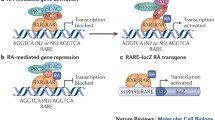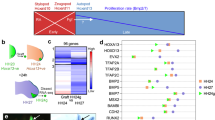Abstract
ROR-1 is a member of the ROR family of tyrosine kinase like orphan receptors and is highly conserved among various species. We have isolated the chick ROR-1 (cROR-1) and show that cROR-1 expression is high and restricted to the proximal limb region until HH-stage 25. At later stages, expression spreads towards the distal limb region. In order to determine the signals that control cROR-1 expression, factors known to be involved in limb patterning (FGFs, BMPs, SHH, retinoic acid) were applied to the developing limb. Whereas neither FGFs, BMPs, nor SHH affected cROR-1 expression, upregulation could be achieved by ectopic application of retinoic acid to the distal limb region. As retinoic acid also upregulated retinoic acid receptor beta (Rar-β), we assume that cROR-1 upregulation is mediated by Rar-β. We conclude that ROR-1 signaling is an independently regulated pathway, which is involved in late rather than early limb development.




Similar content being viewed by others
References
Afzal AR, Rajab A, Fenske CD, Oldridge M, Elanko N, Ternes-Pereira E, Tüysüz B, Murday VA, Patton MA, Wilkie AOM, Jeffery S (2000) Recessive Robinow syndrome, allelic to dominant brachydactyly type B, is caused by mutation of ROR-2. Nat Genet 25:419–422
Al-Shawi R, Ashton SV, Underwood C, Simons JP (2001) Expression of the ROR-1 and ROR-2 receptor tyrosine kinase genes during mouse development. Dev Genes Evol 211:161–171
Bell E, Ensini M, Gulisano M, Lumsden A (2001) Dynamic domains of gene expression in the early avian forebrain. Dev Biol 236:76–88
Capdevila J, Izpisúa Belmonte JC (2001) Patterning mechanisms controlling vertebrate limb development. Annu Rev Cell Dev Biol 17:87–132
Capdevila J, Tsukui T, Rodríguez-Esteban C, Zappavigna V, Izpisúa-Belmonte JC (1999) Control of vertebrate limb outgrowth by the proximal factor Meis2 and distal antagonism of BMPs by Gremlin. Mol Cell 4:839–849
Church VL, Francis-West P (2002) Wnt signalling during limb development. Int J Dev Biol 46:927–936
Church V, Nohno T, Linker C, Marcelle C, Francis-West P (2002) Wnt regulation of chondrocyte differentiation. J Cell Sci 115:4809–4818
DeChiara TM, Kimble RB, Poueymirou WT, Rojas J, Masiakowski P, Valenzuela DM, Yancopoulos GD (2000) ROR-2, encoding a receptor-like tyrosine kinase, is required for cartilage and growth plate development. Nat Genet 24:271–274
Dolle P, Ruberte E, Kastner P, Petkovich M, Stoner CM, Gudas LJ, Chambon P (1989) Differential expression of genes encoding alpha, beta and gamma retinoic acid receptors and CRABP in the developing limbs of the mouse. Nature 342:702–705
Forrester WC, Dell M, Perens E, Garriga G (1999) A C. elegans ROR receptor tyrosine kinase regulates cell motility and asymmetric cell division. Nature 400:881–885
Hamburger V, Hamilton HL (1951) A series of normal stages in the development of the chick embryo. J Morphol 88:49–92
Hikasa H, Shibata M, Hiratani I, Taira M (2002) The Xenopus receptor tyrosine kinase XROR-2 modulates morphogenetic movements of the axial mesoderm and neuroectoderm via Wnt signaling. Development 129:5227–5239
Kist R, Schrewe H, Balling R, Scherer G (2002) Conditional inactivation of Sox9: a mouse model for campomelic dysplasia. Genesis 32:121–123
Martin G (2001) Making a vertebrate limb: new players enter from the wings. BioEssays 23:865–868
Masiakowski P, Carroll RD (1992) A novel family of cell surface receptors with tyrosine kinase-like domain. J Biol Chem 267:26181–26190
Matsuda T, Nomi M, Ikeya M, Kani S, Oishi I, Terashima T, Takada S, Minami Y (2001) Expression of the receptor tyrosine kinase genes, ROR-1 and ROR-2, during mouse development. Mech Dev 105:153–156
Matsuda T, Suzuki H, Oishi I, Kani S, Kuroda Y, Komori T, Sasaki A, Watanabe K, Minami Y (2003) The receptor tyrosine kinase ROR2 associates with the MAGE-family protein Dlxin-1 and regulates its intracellular distribution. J Biol Chem 278:29057–29064
Mendelsohn C, Ruberte E, LeMeur M, Morriss-Kay G, Chambon P (1991) Developmental analysis of the retinoic acid-inducible RAR-beta 2 promoter in transgenic animals. Development 113.723–734
Mendelsohn C, Ruberte E, Chambon P (1992) Retinoid receptors in vertebrate limb development. Dev Biol 152.50–61
Mercader N, Leonardo E, Piedra ME, Martínez-AC, Ros MA, Torres M (2000) Opposing RA and FGF signals control proximodistal vertebrate limb development through regulation of Meis genes. Development 127:3961–3970
Nomi M, Oishi I, Kani S, Suzuki H, Matsuda T, Yoda A, Kitamura M, Itoh K, Takeuchi S, Takeda K, Akira S, Ikeya M, Takada S, Minami Y (2001) Loss of mROR-1 enhances the heart and skeletal abnormalities in mROR-2-deficient mice: redundant and pleiotropic functions of mROR-1 and mROR-2 receptor tyrosine kinases. Mol Cell Biol 21:8329–8335
Oishi I, Sugiyama S, Liu ZJ, Yamamura H, Nishida Y, Minami Y (1997) A novel Drosophila receptor tyrosine kinase expressed specifically in the nervous system. Unique structural features and implication in developmental signaling. J Biol Chem 272:11916–11923
Oishi I, Takeuchi S, Hashimoto R, Nagabukuro A, Ueda T, Liu ZJ, Hatta T, Akira S, Matsuda Y, Yamamura H, Otani H, Minami Y (1999) Spatio-temporally regulated expression of receptor tyrosine kinases, mROR-1, mROR-2, during mouse development: implications in development and function of the nervous system. Gen Cells 4:41–56
Oishi I, Suzuki H, Onishi N, Takada R, Kani S, Ohkawara B, Koshida I, Suzuki K, Yamada G, Schwabe GC, Mundlos S, Shibuya H, Takada S, Minami Y (2003) The receptor tyrosine kinase ROR2 is involved in non-canonical Wnt5a/JNK signalling pathway. Gen Cells 8:645–654
Oldridge M, Fortuna AM, Maringa M, Propping P, Mansour S, Pollitt C, DeChiara TM, Kimble RB, Valenzuela DM, Yancopoulos GD, Wilkie AOM (2000) Dominant mutations in ROR-2, encoding an orphan receptor tyrosine kinase, cause brachydactyly type B. Nat Genet 24:275–278
Pellegrini M, Pantano S, Fumi MP, Lucchini F, Forabosco A (2001) Agenesis of the scapula in Emx2 homozygous mutants. Dev Biol 232:149–156
Rodriguez-Niedenführ M, Papoutsi M, Christ B, Nicolaides KH, Kaisenberg CS von, Tomarev SI, Wilting J (2001) Prox1 is a marker of ectodermal placodes, endodermal compartments, lymphatic endothelium and lymphangioblasts. Anat Embryol 204:399–406
Saldanha J, Singh J, Mahadevan D (1998) Identification of a Frizzled-like cysteine rich domain in the extracellular region of developmental receptor tyrosine kinases. Protein Sci 7:1632–1635
Schofield JN, Rowe A, Brickell PM (1992) Position-dependence of retinoic acid receptor-beta gene expression in the chick limb bud. Dev Biol 152:344–353
Schwabe GC, Tinschert S, Buschow C, Meinecke P, Wolff G, Gillessen-Kaesbach G, Oldridge M, Wilkie AO, Komec R, Mundlos S (2000) Distinct mutations in the receptor tyrosine kinase gene ROR-2 cause brachydactyly type B. Am J Hum Genet 67:822–831
Sucov HM, Murakami KK, Evans RM (1990) Characterization of an autoregulated response element in the mouse retinoic acid receptor type beta gene. Proc Natl Acad Sci USA 87:5392–5396
Takeuchi S, Takeda K, Oishi I, Nomi M, Ikeya M, Itoh K, Tamura S, Ueda T, Hatta T, Otani H, Terashima T, Takada S, Yamamura H, Akira S, Minami Y (2000) Mouse ROR-2 receptor tyrosine kinase is required for the heart development and limb formation. Gen Cells 5:71–78
The H de, Vivanco-Ruiz MM, Tiollais P, Stunnenberg H, Dejean A (1990) Identification of a retinoic acid responsive element in the retinoic acid receptor beta gene. Nature 343:177–180
Tickle C, Münsterberg A (2001) Vertebrate limb development: the early stages in chick and mouse. Curr Opin Genet Dev 11:476–481
Timmons PM, Wallin J, Rigby PW, Balling R (1994) Expression and function of Pax 1 during development of the pectoral girdle. Development 120:2773–2785
van Bokhoven H, Celli J, Kayserili H, van Beusekom E, Balci S, Brussel W, Skovby F, Kerr B, Percin EF, Akarsu N, Brunner HG (2000) Mutation of the gene encoding the ROR-2 tyrosine kinase causes autosomal recessive Robinow syndrome. Nat Genet 25:423–426
Wallin J, Wilting J, Koseki H, Fritsch R, Christ B, Balling R (1994) The role of Pax-1 in axial skeleton development. Development 120:1109–1121
Wilson C, Goberdhan DC, Steller H (1993) Dror, a potential neurotrophic receptor gene, encodes a Drosophila homolog of the vertebrate ROR family of Trk-related receptor tyrosine kinases. Proc Natl Acad Sci USA 90:7109–7113
Acknowledgements
The authors thank M. Ast, U. Pein, A. Bölts, E. Gimbel, S. Konradi, L. Koschny, G. Frank, M. Schüttoff, and S. Antoni for their excellent technical assistance. The emx-2 plasmid was kindly provided by A. Lumsden and the pax-1 plasmid by M. Goulding. This study was supported by the Deutsche Forschungsgemeinschaft (SFB-592, A1 and Ch44/14-2).
Author information
Authors and Affiliations
Corresponding author
Rights and permissions
About this article
Cite this article
Rodriguez-Niedenführ, M., Pröls, F. & Christ, B. Expression and regulation of ROR-1 during early avian limb development. Anat Embryol 207, 495–502 (2004). https://doi.org/10.1007/s00429-004-0381-6
Accepted:
Published:
Issue Date:
DOI: https://doi.org/10.1007/s00429-004-0381-6




